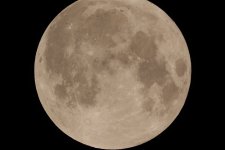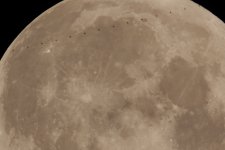- Messages
- 153
- Reaction score
- 265
- Points
- 198
allSky Camera 08-11-2024 Clouds, Stars, Aircraft, Satellites, Meteorites and Green Aurora.
I could not post this to X, said I have a 5 meg limit.
This was absolutely stunning. You guys are amazing.
Welcome to the PMBug forums - a watering hole for folks interested in gold, silver, precious metals, sound money, investing, market and economic news, central bank monetary policies, politics and more.
Why not register an account and join the discussions? When you register an account and log in, you may enjoy additional benefits including no Google ads, market data/charts, access to trade/barter with the community and much more. Registering an account is free - you have nothing to lose!
allSky Camera 08-11-2024 Clouds, Stars, Aircraft, Satellites, Meteorites and Green Aurora.
I could not post this to X, said I have a 5 meg limit.
SpaceX is targeting Tuesday, August 27 at 3:38 a.m. ET for Falcon 9’s launch of Polaris Dawn to low-Earth orbit from Launch Complex 39A at NASA’s Kennedy Space Center in Florida. There are two additional launch opportunities within the four-hour window at 5:23 a.m. ET and 7:09 a.m. ET. If needed, backup opportunities are available on Wednesday, August 28 at the same times.
A live webcast of this mission will begin about 3.5 hours prior to liftoff, which you can watch here and on X @SpaceX.
The Dragon spacecraft supporting this mission previously flew Crew-1 to and from the International Space Station, and Inspiration4, the first all-civilian mission to orbit. This will be the fourth flight for the first stage booster supporting this mission, which previously launched Crew-8 and two Starlink missions. Following stage separation, Falcon 9’s first stage will land on the A Shortfall of Gravitas droneship stationed in the Atlantic Ocean.
MISSION OBJECTIVES
During their multi-day mission to orbit, Dragon and the crew will endeavor to reach the highest Earth orbit ever flown since the Apollo program and participate in the first-ever extravehicular activity (EVA) by commercial astronauts wearing SpaceX-developed EVA suits. They will also conduct 36 research studies and experiments from 31 partners designed to advance both human health on Earth and during long-duration spaceflight, and test Starlink laser-based communications in space.
The Polaris Dawn crew will combine their expertise, knowledge, and passion for spaceflight to further human space exploration. This will be the first human spaceflight for Mission Pilot Kidd Poteet, Mission Specialist Sarah Gillis, and Mission Specialist and Medical Officer Anna Menon. Mission Commander Jared Isaacman previously flew to space as commander of Inspiration4. This will also be the first time two SpaceX employees will be part of a human spaceflight crew, providing valuable insight to future missions on the road to making life multiplanetary.
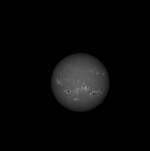
Awesome image. In contrast, my shot of the sun was a single hand held shot with just a white light filter. I had a lot of yard work to do today so that's what I could fit in.Still recovering from some surgery. I tried to get back in the saddle again today. Here's an image of the photosphere with a Calcium filter.
Best 100 images from 2480 images taken. Processed with FireCapture.
80mm refractor, Lunt B1800 filter and ASI533mm camera.
https://www.astrobin.../full/2hbj8a/0/
View attachment 13653
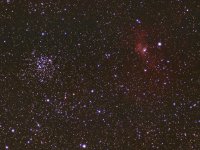
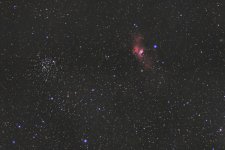
Huge improvement. Excellent study on the progress that processing has made.13 years ago today I captured this image of The Bubble Nebula along with the Cassiopeia Salt-andPepper Cluster. I decided to re-process it this morning with modern tools I did not have at the time (BlurXterminator, NoiseXTerminator, StarXterminator).
Original
View attachment 13660
Re-process:
View attachment 13659
Date: 8/25/2011
Camera: Canon EOS-20D modified
Telescope: 110mm f/7 ED refractor (orion)
Exposure: 150x2min (5hr total) at ISO 800
About: The bubble nebula lies about 11,000 light years away in theconstellation Cassiopeia
Thanks! I was surprised how bad the data was on this one before processing. Terrible "walking noise" and very bad gradient (poor flat frame technique). Itching to get some new data when weather allows. It's been too long.Huge improvement. Excellent study on the progress that processing has made.
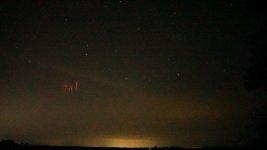
I hear you, but you gotta realize the dewpoint much of this summer here almost matches the temperature. So let's say it's 74 where you're at. How do you feel when the dewpoint is 72? Just saying.^^^ I'd be tempted to kill for those temps. lol
Yea, it's a lot drier here, but I'd still like some cool night time temps. It's not gotten below 82 at night for at least two whole Months.I hear you, but you gotta realize the dewpoint much of this summer here almost matches the temperature. So let's say it's 74 where you're at. How do you feel when the dewpoint is 72? Just saying.
This forecast is nice reprieve though.
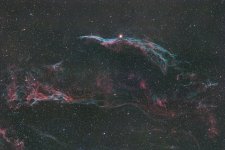
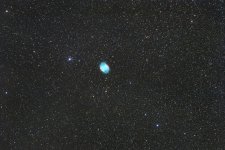
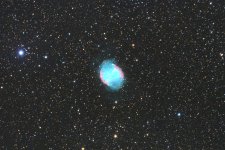
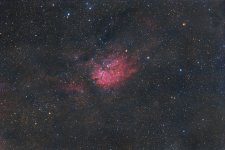
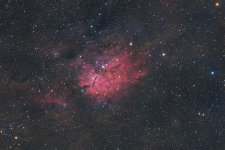
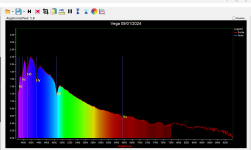
Very nice work. One of these days I'll have to get that device and give spectroscopy a try. Seems a little more in reach than when I was researching it 20+ years ago.Spectroscopy of stars can tell us their chemical make-up and temperature.
Last night (09/01/2024) I captured Vega and here is it's spectrum. The device used to capture the spectra only costs $210 can be found here - https://rspec-astro.com/
It can even be mounted on a DSLR.View attachment 13711
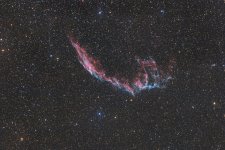
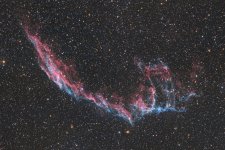
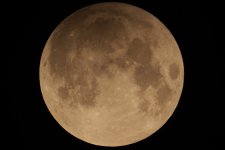
Thanks! Yeah very little sleep for me lately.Stunning captures I guess it was a late night.
